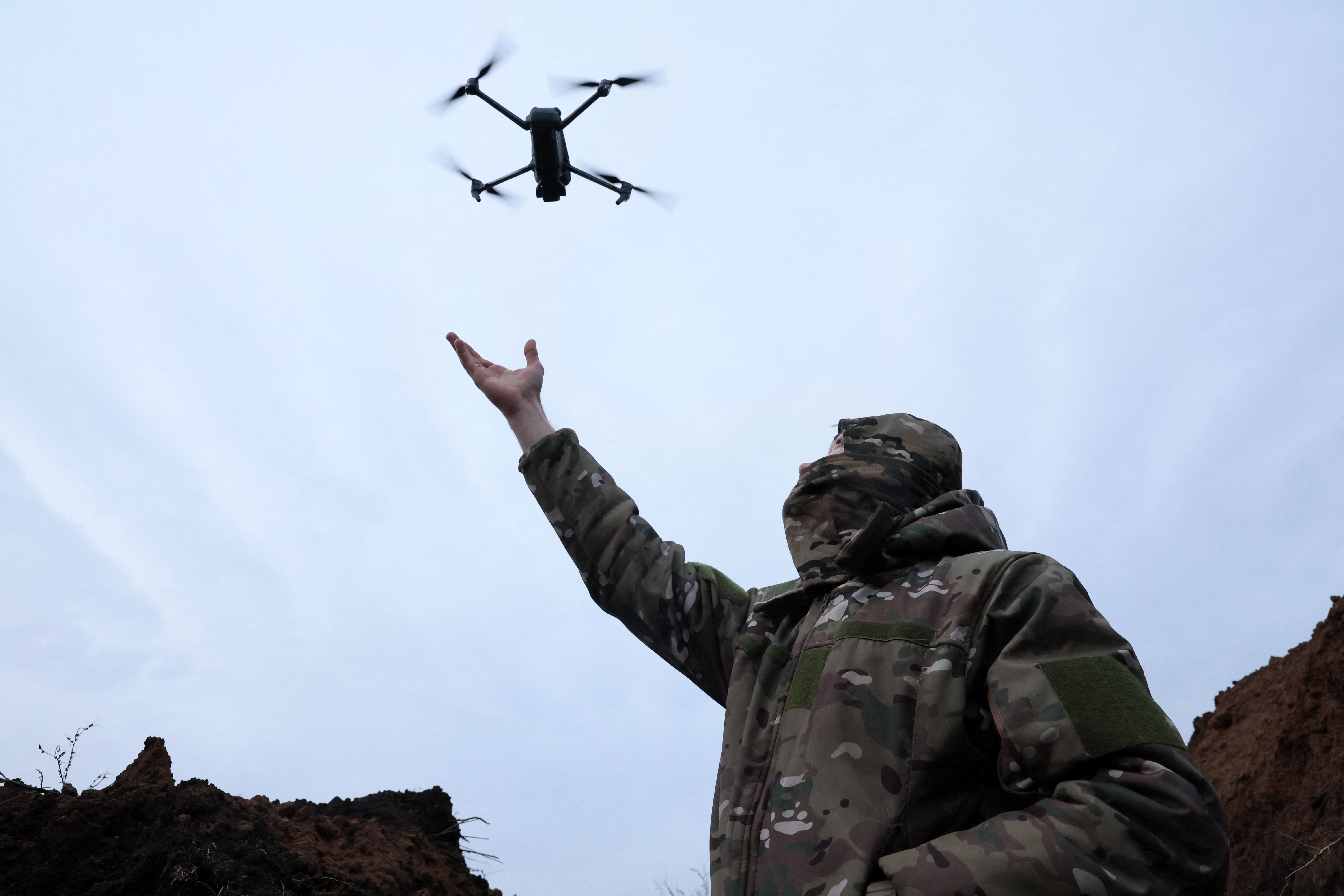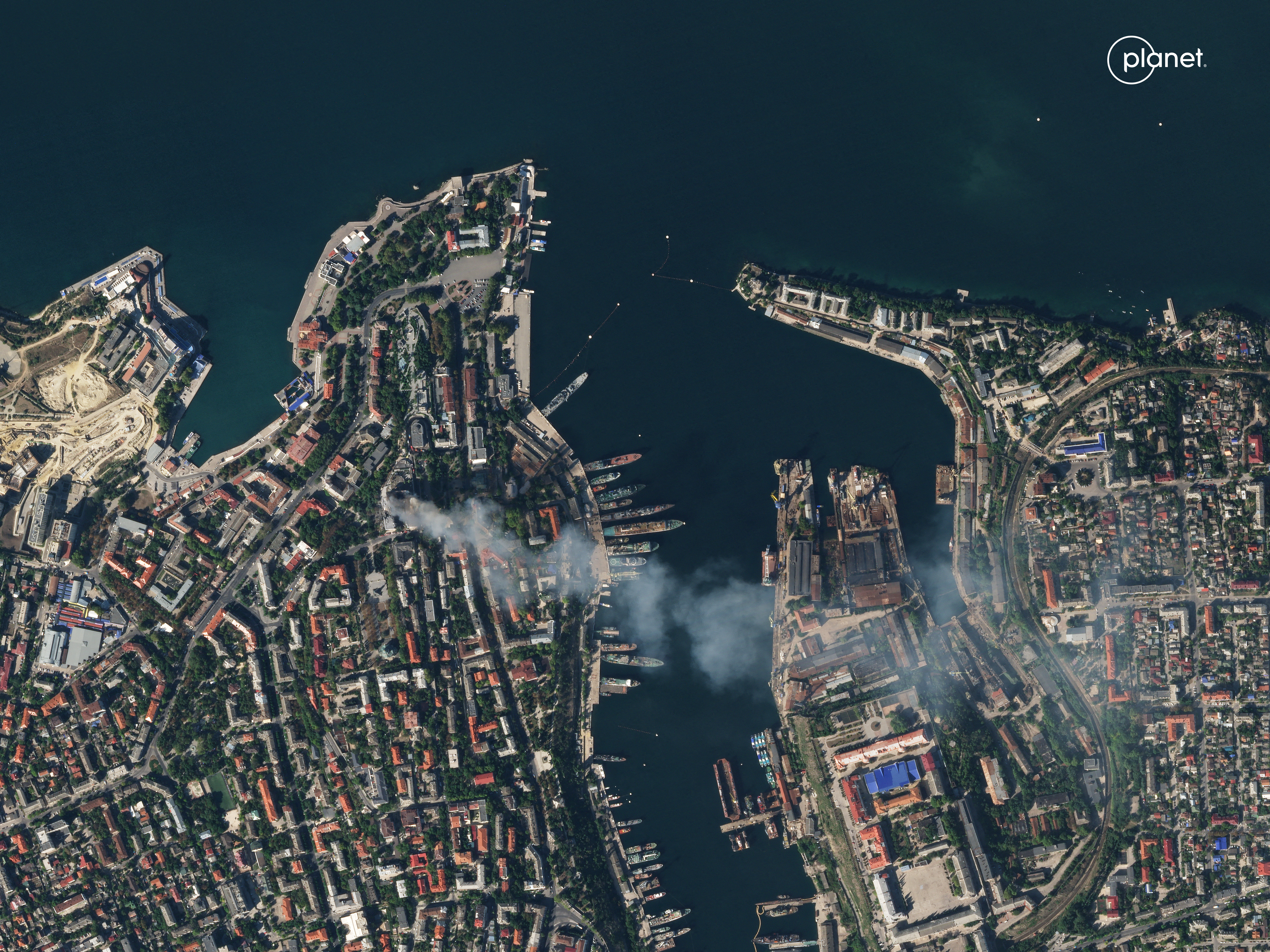
As Ukraine approaches the second anniversary of Russia’s full-scale invasion, it plans to produce more if its own ammunition and key weapons systems.
The goal of greater self-sufficiency comes as Ukraine’s Western allies meet increasing political resistance to military aid and Russia ramps up weapons production.
Last month, Ukraine’s prime minister, Denys Shmyhal, said the country plans to increase its domestic weapons production sixfold this year.
Ukraine’s defence industry has already begun to expand. Strategic industries minister Oleksandr Kamyshin said Ukraine last year doubled its ammunition production for NATO-calibre artillery systems.
President Volodymyr Zelenskyy said it had produced three times more equipment and weapons than in the first year of the war. That included armored vehicles and anti-tank missile systems.
But it’s in unmanned systems that Ukraine aims to be a global pioneer.
Almost 200 companies produced drones in Ukraine last year, up from seven in 2022, and their production increased 100-fold, said Shmyal.
That meant Ukraine was already producing 90 percent of the drones it uses, Zelenskyy said during a meeting with the joint chiefs this month.
The armed forces approved eight new models for procurement last month alone.

On Tuesday, Zelenskyy explained why. He founded the Unmanned Systems Forces, suggesting “special units” would be embedded in the army, air force and navy, and promised “constant scaling of production” to keep them supplied.
“Our task this year is not only to bolster our sky shield and Ukraine’s long-range capabilities to the fullest extent possible, but also to inflict maximum systemic losses on Russia,” Zelenskyy said.
As part of that goal, Ukraine plans to produce a million light drones and 11,000 medium- and long-range drones, the latter with a range of more than 1,000km (620 miles), said Kamyshin.
Ukraine had “established production” and a “financing plan” to achieve this, Rustem Umyerov, defence minister, told a meeting of the G7 representatives in Kyiv last December.
Days before he was dismissed, Valerii Zaluzhny, commander in chief, wrote that unmanned systems were “almost the only tool” to break the current stalemate, making up for Russia’s superiority in heavy equipment and personnel.
Experts tell Al Jazeera Ukraine’s ambitions are realistic.
“Kyiv certainly has the capacity to mass produce FPV [first person viewer] UAVs [unmanned aerial vehicles] given that many of these are based on commercial or hobbyist products,” Douglas Barrie, senior fellow for military aerospace at the International Institute for Strategic Studies (IISS), a think tank, told Al Jazeera.
“Manufacturing larger multi-role UAVs is more demanding, but again Kyiv has the ability to do this, if on a far smaller scale,” Barrie said.
“After the fall of the USSR, [Ukraine] was one of few countries that had a functioning aircraft engine industry,” Pieter Wezeman, senior researcher at the Stockholm International Peace Research Institute (SIPRI), told Al Jazeera.
“They can use that knowledge to rebuild a missile or a drone production capacity. It’s not coming from nowhere,” said Wezeman, whose research focuses on arms transfers and military production.
Early in the war, Ukraine repurposed commercially available FPV drones to drop grenades into the hatches of parked Russian tanks, instantly killing their crews. They offered an added propaganda bonus: drones could beam back video of the kills, allowing Ukraine to humiliate the Russian armed forces while boosting their own morale.
Ukraine believes building these drones more cheaply by itself would offer it more bang for the buck, cycle military expenditure back into its tax base and one day produce export revenue.
“Basically, they want to build a million flying munition pieces,” said Wezeman. “They will need some foreign components – a little chip, a camera like the one in a mobile phone… it’s not as extreme as it may sound.”
Oleksiy Danilov, who heads Ukraine’s National Defence and Security Council, recently claimed that Ukraine was already among the top three drone manufacturers in the world.
Russia’s plans to produce more than 32,000 drones each year by 2030 seem tame in comparison to Ukraine’s. Unable to match Ukraine’s production, Russia agreed to pay Iran $1.75bn for 6,000 Shahed drones, Ukrainian hackers recently revealed.
Soviet stuff and other Ukrainian mysteries
Suddenly last summer, Ukraine used a concert of unmanned systems to strike the occupied Crimean Peninsula with devastating effect.
On August 23, it destroyed a Russian S-400 anti-aircraft missile system 120km (74 miles) from the front line. On September 12, a combination of 10 drones and cruise missiles crippled a Russian submarine and a landing ship undergoing maintenance at the Sevastopol dry docks.
Two days later, surface drones struck two patrol ships and a missile corvette, while missiles destroyed a second S-400 battery in western Crimea’s Yevpatoria.
The reason for the escalation was Russia’s withdrawal from the Black Sea Grain Initiative, which allowed Ukraine to export agricultural goods. These are a lifeline for its economy and war effort, bringing it $23bn last year.

The most crippling strikes were yet to come.
On September 20, Ukraine destroyed half the Black Sea Fleet’s communications headquarters in Verkhnosadove northeast of the fleet base in Sevastopol, and two days later hit the fleet command headquarters in Sevastopol itself, claiming to have killed 34 officers, including fleet commander Admiral Viktor Sokolov.
Ukraine built up a sense of mystique around its weapons systems during this time, claiming to have developed a missile capable of travelling 700km (435 miles) and to have put variants of its naval drone into experimental operational use with success.
“The missiles used against Crimea may very well go back to missiles Ukraine developed before the war started,” said Wezeman. Ukraine was known to be developing the Hrim-2, a short-range ballistic missile for Saudi Arabia. “They may have continued that project and used prototypes of that or other preproduction missiles,” said Wezeman.
Ukraine’s ranged strikes have continued.
Last month, Ukraine sent drones 1,250km (780 miles) to blow up a Novatek gas processing plant near the Russian city of St Petersburg, forcing the company to suspend operations. Last week, a wolf pack of six drones hunted down and sank the missile corvette Ivanovets off Crimea.
The astonishing success of this remote warfare is that lacking a fleet, Ukraine has nonetheless managed to secure a corridor for grain ships in the Black Sea. More than 600 ships have safely used it since Russia announced it was shutting down traffic to Ukraine’s ports.
A battlefield laboratory
Defence minister Umerov last year invited Western defence companies to invest in Ukraine, enticing them with a $7bn procurement budget for the year.
Apart from low labour costs, Ukraine offers the world’s largest and most active battlefield to test new designs. Although Israel’s war in Gaza now claims much of the world’s attention, large numbers of personnel from the Russian and Ukrainian sides are reportedly dying on Ukraine’s battlefields every day.
“The Western companies want to have access to the battlefield so they can have feedback on their systems. They need to know if they are ready for the future wars … so Ukraine is leveraging this to create the industrial base,” Tymofiy Mylovanov, the director of the Kyiv School of Economics, told Al Jazeera.

Ukrainians are themselves rushing to cash in on the industry, he said.
“We have… a lot of garage, Steve Jobs-style innovators, some [in] hardware, some software, some just assembly, but we’re talking hundreds if not thousands of companies,” he said. “This area is really booming right now… The talent from the entire economy went into miltech,” he said, using shorthand for military technology.
Proximity to the battlefield offers the industry a quick feedback loop.
“There’s also a lot of military personnel being advisers, co-owners, members of startup teams,” said Mylovanov.
“People who are engineers themselves are on the front lines deploying their own equipment and immediately fixing it.”
Domestic production would also tighten the loop to market, he said.
“I have seen Polish military companies adjust their products by several generations already in two years, just to respond to what’s happening,” said Mylovanov.
“There’s definitely been a level of openness on the part of many, many Western defence companies taking the first step and entering into very basic level discussions with the Ukrainians,” Elisabeth Gosselin Malo, a defence correspondent for Defence News, told Al Jazeera.
But the safety of personnel is a concern, she said. Whereas last winter Russia attempted to destroy Ukraine’s energy infrastructure, since December 29, it has used drones and missiles to target defence industries.
“We’ve seen cooperation increase in smaller steps – first entering into a cooperation agreement, providing them with systems, then maybe sending a few operators to train people there, and a few companies took it a little further, maybe assembling a few parts in Kyiv,” said Gosselin Malo.
For this reason, some contractors have recently opted to base production facilities in nearby Poland and Lithuania, which are under NATO’s security umbrella.
Ukrainians have decided to cope differently.
One manufacturer, TAF Drones, dispersed production to a dozen locations in six cities and changes those locations every three months, CEO Oleksandr Yakovenko recently told the TV channel Espresso.
Despite such difficulties, Turkish drone manufacturer Baykar recently revealed it was building a factory in Ukraine to produce about 120 drones a year.
Germany’s Rheinmetall, among the world’s 30 largest defence industries, last year established a joint venture to build armoured vehicles in Ukraine “to assure its strategic autonomy”. Finnish armoured vehicle maker Patria is also said to be considering a joint venture in Ukraine.
Others may follow, including Belgium and France. United States President Joe Biden met with leaders of venture capital firms at the White House last month to encourage investment in Ukraine.
Contactless, robotic war
Perhaps the most difficult period of this war for Ukraine came after it defeated Russia’s initial assault to take Kyiv and the entire southern littoral in early 2022.
Russia dug in and imposed on Ukraine a war of attrition, steamrolling over a series of eastern cities – Severodonetsk, Lysychansk and Bakhmut – with relentless manned assaults that produced a huge loss of life.
Ukraine allowed itself to be drawn into this urban warfare, reasoning that it killed far more attackers than defenders and expecting Russian President Vladimir Putin to hit a wall recruiting new troops.
But Putin raised half a million new troops without much political backlash last year and expects to do the same this year.
Zaluzhny’s insistence that Ukraine do the same may have brought him a step closer to dismissal on February 9.
“Russia has taken a different approach by not thinking in terms of smart arms but in terms of manpower and surface warfare and large kill offensives – old style,” said Wezeman. “They have failed but it has put Ukraine in a very hard position.”
Ukraine’s position, he said, was, “We need the smart weapons because we’re not going to sacrifice our soldiers in the same way as Russia.”
So, Ukraine is innovating.
In January it unveiled the Sirko-S1, a four-wheeled robot that autonomously follows troops into battle, conducts reconnaissance and helps evacuate the wounded. In December, Ukraine’s Security Service (SBU) revealed the Mamai, a new surface drone with a top speed of 110km/h (68 miles/h), claiming it was “the fastest object on the Black Sea to date”.
Given Russia’s highly developed electronic warfare, which disables guided munitions by scrambling their satellite positioning signals, Ukraine is focusing on developing ballistic munitions.
“A smart platform gets close enough so it can use a dumb, non-suppressible weapon to actually hit precisely enough,” explained Mylovanov.
He saw a bright unmanned future made in Ukraine, whose youth will fight in the lab, not in the mud.
“I think in a couple of years, [the world will have] walking or self-driving platforms with a sniper rifle that get deployed for surgical strikes.”
“But yes,” he said, recalling the present. “We need bullets, we need shells.”







